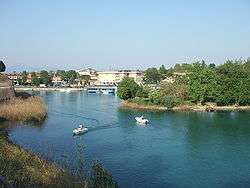Mincio
The Mincio (Italian pronunciation: [ˈmintʃo]; Latin: Mincius, Ancient Greek: Minchios, Μίγχιος) is a river in the Lombardy region of northern Italy.

| Mincio/Sarca | |
|---|---|
 The Mincio at Peschiera del Garda. | |
| Location | |
| Country | Italy |
| Physical characteristics | |
| Source | |
| • location | Pinzolo, Italy (Sarca), Peschiera del Garda, Italy (Mincio) |
| • elevation | 770 m (2,530 ft) (Sarca); 65 m (213 ft) (Mincio) |
| Mouth | Po |
• coordinates | 45°04′16″N 10°58′55″E |
| Length | 194 km (121 mi) (total); 78 km (48 mi) (Sarca) 41 km (25 mi) (Lake Garda); 75 km (47 mi) (Mincio) |
| Basin size | 2,859 km2 (1,104 sq mi) |
| Discharge | |
| • average | 60 m3/s (2,100 cu ft/s) |
| Basin features | |
| Progression | Po→ Adriatic Sea |
The river is the main outlet of Lake Garda. It is a part of the Sarca-Mincio river system which also includes the river Sarca and the Lake Garda. The river starts from the south-eastern tip of the lake at the town of Peschiera del Garda and then flows from there for about 65 kilometres (40 mi) past Mantua and into the river Po. From Lake Garda until it reaches Pozzolo, it forms the boundary between Veneto and Lombardy.
At Mantua the Mincio was widened in the late 12th century, forming a series of three (originally four) lakes that skirt the edges of the old city. The original settlement here, dating from about 2000 BC, was on an island in the Mincio.
The former lower part of the course of the Mincio flowed into the Adriatic Sea near Adria until the breach at Cucca in 589, roughly following the course of the river that is currently known by the name of Canal Bianco; it had been a waterway from the sea to the lake until then.
In 452 CE, Attila the Hun received an embassy sent by the Western Roman Emperor Valentinian III near this river. The Roman delegation was led by Pope Leo I. After this meeting, Attila withdrew from Italy.[1]
The last act of Verdi's opera Rigoletto is set just outside Mantua, at an inn on the banks of the Mincio.
References
- Kelly, Christopher (2009). The End of Empire: Attila the Hun and the Fall of Rome. New York: W. W. Norton. p. 262. ISBN 978-0-393-06196-3.
- (in Italian) Rubis Zemella: La mia Polesella perduta, printed by his own (1992) and reprinted by A.V.I.S. di Polesella (1998).
External links
- . New International Encyclopedia. 1905.